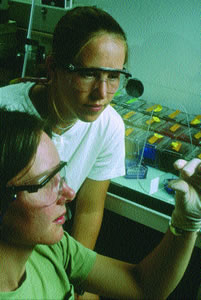 |
||||
|
Girls in School & Engineering
Girls in Public School:
|
|
|||
|
|
||||

Violence(s) and Silence(s) in Engineering ClassroomsKaren L. Tonso - 1997 By finding that young women deny these violences, we move toward better understandings of the extent to which women's mistreatment becomes normalized in our society. While investigating how engineering students acquire and share knowledge as they work in teams on real-world engineering projects, undercurrents of violence became evident. For instance, one engineering professor repeatedly used violent metaphors to describe engineering work. When discussing how students should brainstorm ideas about their project and select the most salient issues, he advised the students to "make five or six blind stabs with a bayonet" into the pool of ideas. In addition, some of the men students used confrontational techniques in the guise of communicating. Yet women students rarely made remarks about their professors' or peers' actions. In two semesters of classroom research, I heard only one such remark spoken in the presence of other students - a young woman noted that "she hated to wear a dress to class, because everyone hassled her when she wore a dress." I was puzzled about the inconsistency between my observations of the classroom and the silences of the students. However, when I later saw myself in a similar silenced role as a student in an engineering doctoral seminar, I moved from perplexed to particularly frustrated at warp speed. In this paper, I begin to explore some of the ways that violences structure women and women's lives. (This is a work in progress and I anticipate that these ideas will continue to grow as I complete my dissertation research in the next two years.) Using primarily ethnographic methods of participant observations and interviews, I gathered data on this campus in two classrooms: a sophomore class in the Spring of 1993 and a freshman class in the Spring of 1995. Currently, there is little in the "women in engineering" research literature about developing engineering identities and the friction between women's vision of themselves as engineers and visions of "woman engineer" held by men engineers. I suspect that some of the violences present in engineering and engineering education serve to constrain the identities available to women engineers and to maintain an engineering culture centered around prototypically masculine "features." Using one experience I had as a doctoral student in education, I suggest that engineering is by no means unique (though it may well be an extreme example) and that violences deserve more research to adequately account for their impact in our society.
Conceptual Framework My current research grows out of a desire to develop more comprehensive pictures of women's embeddedness in social and cultural systems. I remain disappointed with much of the research into gender issues (e. g., AAUW, 1992; Belenky, Clinchy, Goldberger, & Tarule, 1986; Benbow, 1988; Benbow & Stanley, 1980; Chodorow, 1978; Fennema, 1990; Fennema & Carpenter, 1981; Fennema & Peterson, 1987; Fennema & Sherman, 1978; Lynn Friedman, 1989; Gilligan, 1982; Hall & Sandler, 1982, 1984; Maccoby & Jacklin, 1974; Sadker & Sadker, 1994; Sandler & Hall, 1986; Sandler, 1993; Tannen, 1990), because this earlier research overlooked contributions that larger societal structures impose on women. In fact, much of this research provided "cures" centered on changes women must make, without systematic critiques of social institutions. I feared that these "cures" placed an unfair burden on women and created the potential for blaming women for the situation if women were unable to change it. It seemed to me that these solutions overlooked the complexities of women's situatedness and gave them little credit for navigating difficult social systems. For me, anthropological and sociological research perspectives appeared to offer ways of researching women's embeddedness (e. g., Holland & Eisenhart, 1990; Hewitt & Seymour, 1994). In particular, Lave and Wenger's (1991) situated learning theory provided a starting point for my research. In this theory, being a member of a community - developing an identity within a community - implies a shared sense of cultural knowledge that gives meaning to who participants are and what they do within the community. Rather than knowledge being held in the minds of individuals and separable from social interactions, anthropologists posit that knowledge is held in the culture and spread over and among the persons, artifacts, and structure. Knowledge is neither separable from context, nor independent of it, but a way of being in the world, where "agent, activity, and world mutually constitute each other" (Lave & Wenger, 1991, p. 33). Learning, then, is the process of becoming a full participant in sociocultural practices. Knowledge comes from participating over time in the everyday, practical activities of the community. Thus, knowledge resides in historically developed systems of meaning. In engineering, these systems of meaning encompass technical language, tools of the engineering trade, interactional routines, and accepted practices for doing engineering work. As student engineers become engineers, they become proficient practitioners in these systems of meaning; they enact these systems of meaning. Situated learning theory provides a lens to investigate the ways that individuals shape, and are shaped by context (not only the here-and-now of social interactions, but also students' embeddedness in a system with historical, social, and cultural underpinnings). However, situated learning theory alone does not meet all of my research goals. In particular:
Prior Identity Lave and Wenger's theory developed from their studies of traditional apprenticeships, where participants came from similar backgrounds (or their backgrounds were ignored as if they were irrelevant). This is not the case for student engineers. In fact, because increasing numbers of today's students come from communities historically underrepresented among engineers, diversity of student engineers is increasing. Situated learning theory fails to account for wide-ranging differences among novice engineers. By thinking about prior knowledge as identities that students bring to their college studies, I am developing a way to incorporate differences that result from a wide variety of sources: gender socialization and ethnicity, as well as variations in cultural capital, lived experiences, and academic preparation. I focus on the ways these differences tend to privilege certain groups of student engineers and disadvantage others, particularly when campus-wide policies and classroom organizational practices do little either to identify differences in students or to provide opportunities that serve all students. Outcome Identity According to Lave and Wenger's theory, apprentices strive toward an outcome identity, such as becoming a tailor. Following Kondo, I suspect that "engineer" cannot be reduced to one identifiable set of mature practices. "...[I]dentity is not a static object, but a creative process....[H]uman beings create, construct, work on, and enact their identities, sometimes creatively challenging the limits of the cultural constraints which constitute both what we call selves and the ways those selves can be crafted....[W]e should not speak of 'the self' as a global entity, but of selves in the plural. Perhaps then we can come to appreciate both the insistent rhythms of common cultural idioms, and the many ways they reverberate through people's lives" (Kondo, 1990, p. 48, emphasis in the original). Kondo posits that identities are plural, not only that there are varieties of engineering identities, but also that an individual can exhibit contextual variety. Communities of Practice Finally, situated learning theory contains no mechanism for critiquing communities of practice. Friedman (1991) cautions us to examine critically, not merely accept, these traditions and their impact on women. She points out that "communities have harbored social roles and structures which have been highly oppressive for women" (p. 305) and have operated with "a kind of morally normative legitimacy" (p. 307). Kondo (1990), discussing how Japanese employees developed "worker" identities, described the ways employees redefined certain aspects of "ideal" worker identities. Her suggestion that cultural identities are actively shaped by participants provides a model for considering how women student engineers might reshape engineering identities. In addition, I seek a standard against which to "measure" (characterize and hold up to scrutiny) communities of practice. I believe that Gutmann's (1987, citing Dworkin) equality provides that standard. She argues that all students must be treated as equals; that is, relevant differences must be understood and considered. This is very different from an equality standard where all students are treated the same, regardless of relevant differences. Gutmann reiterates Dworkin's example illustrating how sameness of treatment differs from treatment as equals. In a classroom with blind and sighted students, using the same lessons to teach both kinds of students would guarantee that one or the other would be ill-served, depending on the pedagogy employed. That one can see and another cannot profoundly influences how one teaches. I argue that these kinds of differences must be allowed for legitimate participation. Howe (1993) calls this sort of equality "participatory," suggesting that in a democratic society participation is the more important standard when making judgments about equality. When linked to Lave and Wenger's situated learning theory, legitimate participation is the process that guarantees equality. (Though Lave and Wenger seem to imply this, they do not appear to guarantee it. Here, I strengthen their notions of participation in a community of practice, privileging participation and cultural change over traditions that promote the status quo.) In this participatory equality, different persons with different perspectives, different goals, and different motivations not only have access to education, but also contribute via their participation to develop what a good education might be. That is, participatory equality requires that all persons can openly advocate their own positions without the fear of retaliation. Taking this democratic stance that values participation, I argue that violence is done when participation is constrained. In looking at the narrow issue of violence in my research site and my life, I seek a fuller sense of what counts as violence and wonder: What is violence? How is it construed in the experiences of my research participants and in my own academic life? How does it become normalized in our society? How might we contribute to expanding what counts as violence? How might we expose violence while we enact our research goals? Violences and Silences I start with the dictionary meanings of violence (Webster's New Twentieth Century Dictionary, 1979): Synonyms: vehemence, impetuosity, force, outrage, rage, profanation, injustice, fury, infringement, fierceness, oppression. Unfortunately, violence comes in several forms for women. At the recent Fourth World Conference on Women assembled in Beijing, considerable discourse revolved around issues of physical violence against women. Hillary Rodham Clinton spoke against the systemic violence that pervades the women of the world - rape as a tactic of war, killing of girl babies, burning of women whose dowries are too small, capture into prostitution and slavery, domestic violence, genital mutilation, coercive abortion and sterilization. Rodham Clinton went on to note that "violence against women thrives when there is a 'crisis of silence and acquiescence'" (Tyler, 1995). Even in the United States - a democratic, industrial nation, violences against women persist, though (we hope) not at the same horrific levels reported in Third World countries. Yet, even in the United States - a country that pioneered free speech and open dialogue, women's silence and acquiescence endure. Of particular interest to me as a former engineer currently studying gender issues in engineering education, is the extent to which silence and acquiescence become normalized in our everyday lives. In fact, the ways in which silence and acquiescence become a survival technique. Another variety of violence recently surfaced in discussions of Shannon Faulkner's experiences at The Citadel. This violence is more along the lines of definition seven above - violence as desecration and profanation of women's everyday activities, and in synonyms for violence - infringement and oppression. When Faulkner decided to leave in August, 1995, after only a few days on campus, Royko (1995), the Chicago editorial newspaper writer, wrote a touching and insightful commentary. In his column, he told of similar horrors and degradation faced years before by a (now) gray-haired, Chicago man, previously a working class lad attending a military high school with the sons of privilege. Royko provided a litany of hazing, taunting, and insults that preceded the man's becoming shunned by his classmates for speaking about and resisting his mistreatment. This man ultimately left the military school. In closing, Royko offered to Shannon Faulkner this gray-haired man's consoling thoughts: "If she had endured the abuse of her freshman year, something even worse would have happened to her. She would have become one of them." (Emphasis added) Royko illuminates an unspoken violence - the violence of having to deny one's existence and values to become "one of them." When I entered engineering over 25 years ago, becoming an engineer seemed to imply that I could go out into the world and assume male duties. That presumption comes from an earlier day and age. Times have changed and we must now understand that being forced to adopt, in an unexamined way, these culturally and historically taken-for-granted ways of construing professional identity is a violence against women that not only denies our existence, but also denigrates the importance and honor of women's work. To expect that women "check their identities at the door" constrains our participation - makes us silent and invisible. First, I will tell you the stories of young women student engineers and relate how their men colleagues talked about women students to me. What I hope to make most striking is that the women students rarely spoke of their campus lives in terms that express their mistreatment, while their men student colleagues reveal the disadvantages of being women on the campus. Then, I will talk about the extent to which I caught myself in an identical silent-and-acquiescing mode during one of my doctoral classes in education. From these sets of experiences, I will suggest that we, as researchers, embed ourselves in our women participants' experiences and use what we see to fill the silences that cultural norms perpetuate. Franci and the Issue of Professional Dress As part of a larger research project, I observed two teams of college engineering sophomores - 3 women and 2 men, 1 woman and 4 men. Though I met with these teams over 25 times during the semester and interviewed all students - two of them on two occasions, the students never explicitly referred to any "gender bias" or violence during their college experiences. However, I observed both in every class. Students' lack of awareness was astounding. Franci (a woman student on the team with 3 women and 2 men) commented in her team meeting about being hassled when she wore "professional" dress to another class. Because of the almost total silence related to gender bias and violence, her comments really stood out. This is what happened: As the student teams prepared for their first client meeting (week two), they were told to wear "professional dress," but the professors' advice referred only to men's dress clothing - slacks, jacket, and tie. Further advice about keeping one's jacket on if the client kept his on was given. However, this directive was entirely too vague for the students, and considerable team time was spent negotiating the women's professional dress for all occasions and the men's professional dress for "working" site visits. When one of the male students suggested that they "look nice, but not a suit and tie," one of the female students added "or a jacket and skirt." ... Although the professors implied that all client meetings and site visits required the same professional dress, the students decided to modify their attire to fit different situations. For all indoor presentations and on-site tours (requiring only walking through town and talking to their client or to business owners), the students decided to wear their "best" clothing. For the men, this meant a suit, tie, and dress shoes and, for the women, either a skirt and jacket or dress, nylons, and low-to-medium heels. However, for on-site "work trips," especially the building-by-building survey, the students decided on more casual clothing, such as jeans and t-shirts. For these occasions, the students decided that a suit and tie or skirt and heels were inappropriate when an engineer was measuring the dimensions of doorways and toilet stalls, among other things.... There was another facet to the dress-code discussions beyond the simple "what to wear" issues. During the team's discussions about the attire for their first field visit, Franci wanted the team to leave for the town at 10:15, instead of immediately after her 9:00-9:50 class. By leaving later, Franci would be able to go to class, then return to her dormitory and change into a dress, instead of wearing a dress to class. She remarked that "everybody hassles you" when you wear a dress to class. She was adamant about this, saying, "I hate for them to notice that I am wearing a dress." Doug disagreed with her. He thought that "it's not a big deal. Everybody knows you're in [this class] or have an interview." For these two students, professional dress seemed to serve different purposes. For Doug, being in a suit and tie signaled that he was part of a collective--students in a required class or students looking for work, but for Franci, wearing a dress only emphasized that she was an outsider and set up her being hassled by men students in her other class. When I told this story to my writing group, most of my peers found it interesting, but not earth-shattering. Only when one of our education professors remarked forcefully (especially for this professor), "You can't even wear a dress for crying out loud!," did it become clear to us just how circumscribed women's presence on this engineering campus had become. In fact, students took it for granted that this was just part of being an engineering student and not worthy of notice or comment. That Franci in a dress was out of the ordinary provides evidence of the extent to which these young women are expected to be, in some very real ways, invisible. This is oppressive1.
Becoming "Engineer" - A Glimpse at Gender While gathering data for a classroom ethnography of first-year engineering students, I observed three teams closely (3 women and 2 men, 2 women and 1 man, and 2 women and 2 men - a total of 7 women and 5 men). In one-on-one interviews, I asked what it was like to be the interviewee's gender and then asked if it would be different if they were the other gender. Women students rarely mentioned - and often denied - gender bias. Yet, young men spoke openly about men's fit with engineering, even as they denied gender bias. For me, the young men's ability to enact gender bias, yet deny its existence, speaks volumes about how gender bias becomes normalized. According to men, being a man on this campus meant: Given the fact that I am a man, I think I would much rather be a man going to a campus like this. That's what I've been prepared for. I've been prepared to be a male in society (W-M1, 1:212) For me, it's about as conducive a situation as you'd hope for. This is still a somewhat old-fashioned [place]. By that I mean retaining the white males' approach, you know; you're welcomed with open arms....As far as I'm concerned it's a real natural environment for me. (F-M1, 1:10) Well, a lot of it is just being one of the other guys. Because there's so many guys on this campus....I don't know what it was, but I mean I don't really know any differences between guys....It's not really any different it's about like high school anyway. (M-M1, 1:11) There's still a lot of macho things, the macho ideas about engineering. Not that it's a macho thing to do, but just that males have always done it. (F-M2, 1:16) But being a woman meant: I have yet to meet a woman that has that same approach, that "hand me the wrench and I'll take care of this" [approach]....I think it might be a little bit harder for some of the women to be taken seriously by their classmates. (W-M1, 1:14, 21) I have a feeling that a nontraditional woman student [a student who returned to college some years after graduating from high school] would not be received with the same amount of, they would not be viewed as having the same commitment....I would think it would be very, very hard for a woman, especially one that did not already have a degree in a science, to enter into an engineering program....[Women students] are learning a new language that has been developed by males, [a language] that almost is a second language to women. They think about things differently and when I think about that I think that those women ... are actually smarter than a good deal of the men, because they're not only thinking of things in their own language, but they're learning them in a male language, because mathematics and everything from way back has been developed by a male. (F-M1, 1:10) There's definitely more attention paid to you by the guys. If you're a woman on this campus, you'd definitely get more attention than most places.....Guys are like "there goes one of them." It's different because there's so many guys and it's not like rare or anything to see a woman walking down the street, [but] you notice the women. It's just like [and he gawks wide-eyed]....But as far as school goes, I don't know if there's really any difference. I don't see any difference. I don't see like professors treat them differently or TA's treat them differently or anything. Pretty much, I see everyone is treated the same. (M-M1, 1:12) When you go to a school where most of the people are guys, all the girls automatically get like bumped up into a higher social class...and [with so many guys] wanting to date them, it makes a lot of girls stuck up.... [If you were a woman,] you'd always get hit on, you'd always have a date on Friday night if you wanted it. I mean it would be basically [the] opposite of what I'm feeling3. (F-M2, 1:9,18) For these men, participating on this campus was consistent with male-socialization patterns and women could be expected to have problems becoming engineers and fitting in. These men students viewed women's difficulties as springing not only from an implicit assumption that women must "learn new languages developed by men" and accommodate to (or assimilate into) the prototypically masculine mold, but also from social pressures placed on women because of their scarcity. Though some of the women students commented on how the imbalance between the numbers of women and men contributed to men having fewer dates and women having more, none spoke of it in terms of shifting up in social class. Most women students spoke about how they were treated the same as their men counterparts by professors and most did not comment on the peer social relations, outside of dating. Only one woman student offered a different perspective on women students' relationships with faculty: I think it's a lot like prejudice, I'm not kidding, I mean, guys don't notice it. There is a lot of sexism on this campus and it's from the professors more than anybody else, it really is. I don't think it's the fact that the professors think you're a woman you know. All I think is that they look at you and they say this is a woman and I don't know if it's that they feel their career is threatened or that they feel that you just don't belong in this field or that they want to make sure that you want to be here, so they make it extra hard on you. I don't know what it is. There's a lot of sexism....I'm looking at [it] as this is a challenge. This is not something that I'm going to sit here and go, I mean it upsets me that there's a lot of sexism, but I'm also looking at it as the reason that they're probably sexist toward me is the fact that I'm a woman. Well of course it is....And [they] can just deal with that, because I'm a woman, I'm going to be an engineer. I'm going to come out of [this school] and, you know, it's another one of those prove-you're-wrong, show-you-up type things. (W-M2, 1:16) She never provided specific examples of sexism. She was willing to talk with me about these issues in private, but never mentioned them when I observed in her class and during her team's meetings. Not one woman student noted that engineering encouraged prototypically masculine endeavors. I argue that the underlying assumptions about engineering being a prototypically masculine activity result in women facing a choice between being an engineer and adopting engineering's prototypically masculine ways, or not becoming an engineer. That is, women carry the burden of fitting in and must, in real ways, deny who women are and what women have done in order to fit in. This does violence to women. What concerned me in the experiences of the women student engineers was their silences about these traditions that set up and maintain a "stacked deck." When I was an engineering student over 25 years ago, I probably shared this adoration for engineering. But I honestly thought I had developed a voice and no longer participated in the silence(s) and acquiescence. As with most pious statements of this sort, it simply did not play out that way in situ. I Sit Mute and Acquiesce in a Doctoral Seminar During my doctoral coursework in education, I took a doctoral seminar devoted to reducing bias in educational settings4. In addition to eight or ten doctoral students, almost as many master's degree students registered for the course. The readings challenged even the most proficient doctoral students and seemed, at times, to overwhelm the master's students. Part of the appeal of the course came from the professor's desire that each student focus on those kinds of bias of most interest to the student. During the semester, we were expected to write two papers: the first the beginnings of a literature review in our own area of specialty, the second a more thorough examination of the class readings and an integration of these readings with our particular work. Success in the course depended on not only a clear understanding of this semester's readings, but a well-formulated understanding of an area of specialty to which to apply the readings. Most doctoral students already possessed substantial knowledge in our areas of specialty, derived largely from our own master's courses and ongoing doctoral studies. But for some master's degree students, this was clearly a push. On at least four occasions during the semester, we began class by going around the table and talking about our progress in the specialty areas. Not too surprisingly, I focused on gender issues in math and science education. On each occasion when it became my turn to summarize my progress, one of my men doctoral student colleagues remarked "Oh, let me guess, Karen. You're going to do gender." To which I answered, "Yes, and I guess you'll be doing [his specialty]." Though I quietly seethed, I wrote his remarks off as so much ribbing among doctoral students. I felt that he adequately displayed his own immaturity and petty jealousies, which were beneath comment. I only knew him from a course we took together the previous semester - along with almost 30 other students, hardly an opportunity to become acquainted. During the tenth or eleventh week of the class, we repeated our exchange for the fourth time. As the class continued that day, the professor was, as usual, late with our break. When we finally took a break, I was out the door like a shot and down the hall to the restroom. Four or five of the women master's students entered the restroom after I closed my stall door: I came out of the stall and commented that her solution seemed unfair. I encouraged her to think about it more before she decided, offering to set aside time on a regular basis to chat about her progress or to support her in any way that seemed meaningful to her. She ultimately took a "W" for the course. This meant that the seminar would eventually disappear from her transcript, but that she must pay for another three-hour course in the next semester. Deep in my heart I believed that my silence had contributed to her dilemma. I had my reasons for not confronting this man: his status as the confidante of two senior professors, my existing reputation as someone who was "too extreme," and my desire not to add to his considerable self-importance by acknowledging him further. But these are lame excuses. I did not confront him, the professor gave no comment, and these women master's students determined that studying gender issues was somehow unsafe based on the way I was treated by the other doctoral student. In private, I asked other doctoral students what they thought his comments meant. To a student, his comments were "just kidding around." I went to the professor and told this tale. S/he expressed only mild interest; it was "just kidding around." Nonetheless, the comments worked to reduce the number of qualified people studying gender issues, limited academic discourse, and made outcast those who studied gender, constraining participation in clear ways. In this classroom context, that doctoral student's hassling of me for studying gender represented the norm - violence against "my kind" was an accepted practice. I argue that these kinds of everyday infringement and oppression are the very air we breathe and must be documented and resisted by those of us for whom resistance is a safe endeavor.
Summary In ways that only became clear after catching myself deciding not to speak, I was unfair to my women student engineers when I blithely expected them to notice their own mistreatment and speak out against it. There I was in a classroom composed of almost equal numbers of women and men graduate students - something women student engineers will never experience - and a professor who is an outspoken advocate for reducing bias - another benefit women student engineers will probably never have - and I weighed the alternatives and decided not to confront the man graduate student. My expectations of the young women student engineers failed to take into account their embeddedness in a system and the consequences of resistance within that system. There seems to be an endless recursive loop embedded in societal venues - violence happens, speak against it, become a target for more violence. For me this is distressing and the crux of my dilemma about how to reduce violences. What can we do when we see and document these oppressions? How can we do our research to see these oppressions better? How can we create a forum to discuss these issues? How can we guarantee that our actions do not further endanger our research participants? Though I am aware of overt acts of physical violence against women, there are other subtle and pernicious violences that women contend with daily. By making explicit how these undocumented violences work to limit women's opportunities and constrain both who women can become and who can be valued in our society, we contribute to naming violences and taking a stand against all varieties. My research data indicate that young women are often silent about the particular, subtle violences that play out in their lives. Though we must continue to incorporate these young women's perceptions of the world in our findings, we must also give our own observations of these women status in our work. By finding that young women deny these violences, we move toward better understandings of the extent to which women's mistreatment becomes normalized in our society. That violences exist is an interesting finding, but it seems to me that of more concern is documenting how well- meaning folks manage to create precisely the circumstances that they claim to abhor. I am routinely astonished at the contradictory statements my research participants make. The normalization of violences in our society is not the blindness of selected individuals, nor the workings of some demonic sect, but evidence of the ways that social and cultural systems structure women and women's lives. References
|
||||
 |
|
 |
||







